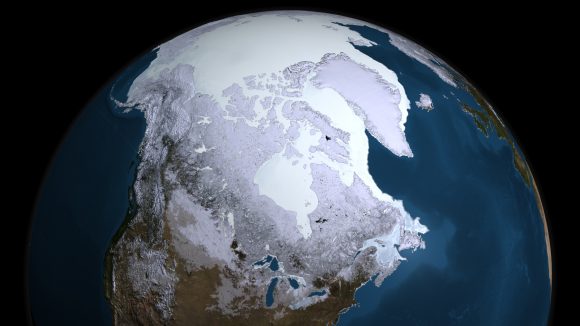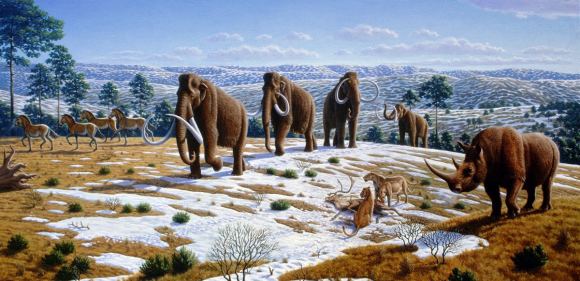According to modern theories of geological evolution, the last major ice age (known as the Pliocene-Quaternary glaciation) began about 2.58 million years ago during the late Pliocene Epoch. Since then, the world has experienced several glacial and interglacial periods, and has been in an inter-glacial period (where the ice sheets have been retreating) ever since the last glacial period ended about 10,000 years ago.
According to new research, this trend experienced a bit of a hiccup during the late Paleolithic era. It was at this time – roughly 12,800 years ago, according to a new study from the University of Kansas – that a comet struck our planet and triggered massive wildfires. This impact also triggered a short glacial period that temporarily reversed the previous period of warming, which had a drastic affect on wildlife and human development.
The study in question, “Extraordinary Biomass-Burning Episode and Impact Winter Triggered by the Younger Dryas Cosmic Impact ~12,800 Years Ago”, was so large that it was divided into two parts. Part I. Ice Cores and Glaciers; and Part II. Lake, Marine, and Terrestrial Sediments, were both recently published by The Journal of Geography, part of the the University of Chicago Press’ series of scientific publications.

Led by Wendy S. Wolbach, a Professor of inorganic chemistry, geochemistry and analytical chemistry at Chicago’s De Paul University, the study was conducted by a team of 24 scientists and included members from the Tennessee Valley Authority (TVA), the Climate Change Institute, the Instituto de Investigaciones en Ciencias de la Tierra (INICIT), the Lawrence Berkeley National Laboratory, and multiple universities.
For the sake of their study, the team combined data from ice core, forest, pollen and other geochemical and isotopic markers obtained from more than 170 different sites across the world. Based on this data, the team concluded that roughly 12,800 years ago, a global disaster was triggered when a stream of fragments from a comet measuring about 100 km (62 mi) in diameter exploded in Earth’s atmosphere and rained down on the surface.
As KU Emeritus Professor of Physics & Astronomy Adrian Melott explained in a KU press release:
“The hypothesis is that a large comet fragmented and the chunks impacted the Earth, causing this disaster. A number of different chemical signatures — carbon dioxide, nitrate, ammonia and others — all seem to indicate that an astonishing 10 percent of the Earth’s land surface, or about 10 million square kilometers, was consumed by fires.”

According to their research, these massive wildfires also caused a massive feedback in Earth’s climate. As fires rushed across much of the planet’s landscape, the smoke and dust clogged the sky and blocked out sunlight. This triggered rapid cooling in the atmosphere, causing plants to die, food sources to dwindle, and ocean levels to drop. Last, but not least, the ice sheets which had been previously retreating began to advance again.
This quasi-ice age, according to the study, lasted about another thousand years. When the climate began to warm again, life began to recover, but was faced with a number of drastic changes. For example, fewer large animals survived, which affected the hunter-gather culture of humans all across North America. This was reflected in the different types of spear points that have been dated to this period.
What’s more, pollen samples obtained from this period indicate that pine forests were likely burned off and were replaced by poplar forests, a species that colonizes cleared areas. The authors also suggest that this impact could have been responsible for the so-called Younger Dryas cool episode. This period occurred roughly 12,000 years ago, where gradual climatic warming was temporarily reversed.
Intrinsic to this period was an increase of biomass burning and the extinctions of larger species during the late Pleistocene period (ca. 2,588,000 to 11,700 years ago). These sudden changes are believed to be what led to severe shifts in human populations, causing a decline during the 1000-year cold period, and leading to the adoption of agriculture and animal husbandry once the climate began to warm again.

In short, this new theory could help explain a number of changes that made humanity what it is today. As Mellot indicated:
“Computations suggest that the impact would have depleted the ozone layer, causing increases in skin cancer and other negative health effects. The impact hypothesis is still a hypothesis, but this study provides a massive amount of evidence, which we argue can only be all explained by a major cosmic impact.”
These studies not only provide insight into the timeline of Earth’s geological evolution, they also sheds light on the history of the Solar System. According to this study, the remnants of the meteor which struck Earth still persist within our Solar System today. Last, but not least, the climate shifts that these impacts created had a profound effect on the evolution of life here on Earth.
Further Reading: Kansas University


If this becomes accepted, the implications for the study of ancient human civilizations is enormous! An absolute game changer.
Perhaps prehistoric “communities” is more accurate, but the effects trickle down the timeline nevertheless.
‘Sup with the 1000-mile-across “meteorite” in the illustration :PP
This is an old story….see this link about work done on the Younger Dryas by Prof Kennett of UCSB: http://www.news.ucsb.edu/2015/015778/cataclysmic-event-certain-age
or see Kennett presentation of 2013 at Goleta Library
https://www.flickr.com/photos/27241501@N03/sets/72157637488260154/